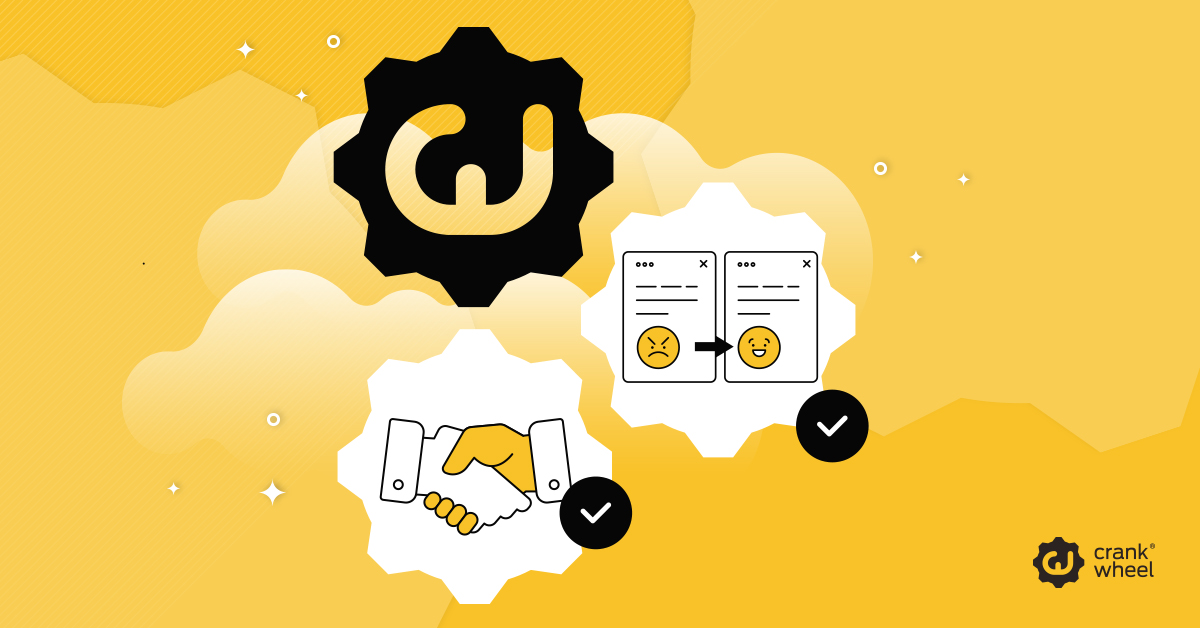Why customer success leaders rely on CrankWheel for complaints and on-boarding
Customer service calls aren’t always easy. In some cases, a call can be substituted for a self-serve experience. Customers are adept at finding out what they need online, or through logging into online accounts (e.g. FAQs, AI-powered bots, videos and other solutions companies roll-out solve a lot of problems) where answers to questions can be found.

In other cases, older customers don’t want or know how to use online accounts and self-serve tools. So, calls are still a normal part of how they get information from a service provider. For these customers, agents on the end of the phone are the best way to ensure the right level of service is received.
However, in other cases, calls are more complicated. An issue has already got to the point whereby several agents and possibly managers have dealt with it, and so a resolution of some kind is needed, quickly. In some sectors, when a company fails to resolve a problem, not only do they lose customers, they could face regulatory fines and other problems.
Customers either need to complain because of a service failing, or they are trying to on-board to a new service, or they need help with something technical and complicated.
When customer service calls are more challenging, and specifically when customers need to be shown something, how are these usually handled?
- Contact center agents can attempt to describe a solution, which may or may not prove successful;
- Agents could suggest a customer uses Live Chat, and then somehow ensures they are able to connect that way (not always easy, or even possible), so that screenshots or potentially screen-sharing can be used;
- Without the right solution to hand, it isn’t possible to connect with a customer using real-time visuals, such as screen-sharing, resulting in an unhappy customer.
- Even when an ad-hoc solution can be used, it often adds to the poor experience a customer is having, making it more stressful and frustrating for them. When customers aren’t happy with the service they’ve received, the worse thing a company can do is compound the problem with attempting a call that is fraught with friction for the customer thanks to technical requirements.
Why is screen-sharing the solution?
Screen-sharing is the easiest most effective way to show customers what they need, reduce complication and friction when trying to understand something. Plus, this solution helps ensure customer success teams can maintain KPIs, such as satisfaction scores, call times, and complaints resolution timescales.
Whether you are on-boarding customers onto a new product or service, or handling complaints, screen-sharing can solve a lot of problems, quickly.
Not only are customers — those that want to use screen-sharing of course — happier, but companies can deliver services more effectively. Screen-sharing is therefore a great way for customer service teams to save time and money. It’s also an effective way to reduce churn, and improve the customer experience.
In both cases, whether a customer has a complaint that needs resolving, or when on-boarding requires real-time visuals and engagement, screen-sharing proves the most effective solution.
Why customer service teams love CrankWheel?
With tens of thousands of customer service (CX) and sales agents using CrankWheel every day, we can confidently state that there are calls happening right now where its being used.
On the types of calls outlined above, where real-time visuals are needed, or the problems are difficult to solve, CrankWheel proves invaluable.
Customer service agents and managers like the fact that no matter what device a customer is calling in from, they can engage with screen-sharing without downloading anything. It’s quick and easy. Making it user-friendly, for agents and customers.
Not only that, but difficult calls can be resolved more easily. Customers can see, clearly, what an agent is trying to explain. With Remote Control, it’s even possible for a customer to have limited or controlled interaction of an agents screen, which makes it significantly easier to get used to a new product or service. No more trying to explain with great difficulty. Instead, agents can demonstrate how something works with real-time visuals.
“Customers love the ease of being able to join a screenshare with no complicated installs, meeting codes, or other hassles. As a result, it is mandatory now for our sales and CX reps.
Finally, a simple, clean and fast screen sharing application!”
– excerpts from some of our glowing reviews.
Benefits of using CrankWheel for customer service:
- Make it easier to clarify and demonstrate a new product or service for customers;
- An interactive and visual experience — show don’t tell;
- Customers can take part in the screens of agents (using Remote Control), thereby giving them a much better understanding of a more complicated product or service;
- When a complaint requires a demo, especially when a problem is technical, then a solution can be provided and presented in a more engaging way than over the phone.
- Reduces churn and increases customer satisfaction ratings;
- Reduces customer service costs, as agents can handle more complicated calls more effectively, whereas queries that aren’t as complicated can be handled by Live Chat agents, even bots and self-serve solutions.
